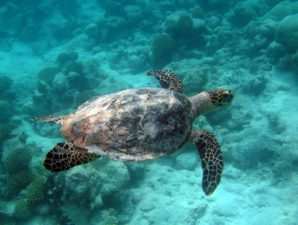9 Nov Turtle Exped
Download the full report here: Nov 2018 BIOT turtle expedition report (PDF)

Executive summary
This scientific expedition to Diego Garcia, British Indian Ocean Territory (BIOT) from 21 November to 11 December 2018 builds on previous conservation research on the ecology of hawksbill and green turtles in the archipelago. The primary objectives were to increase understanding of the numbers and movements of hawksbill turtles nesting on Diego Garcia and to expand existing knowledge of the immature turtle aggregation within the Diego Garcia lagoon.
1. A presentation on sea turtle conservation research in BIOT took place to a packed audience of about 120 military and civilian residents of Diego Garcia on 21 November. At the meeting, volunteers signed up for daytime patrols to assist the science team with surveys of immature turtles in Turtle Cove and with nesting hawksbill satellite tag attachments on the oceanside nesting beach.
2. On Diego Garcia, the sea turtle science team was assisted by 87 volunteers during the equivalent of 114 volunteer days as many volunteers came to assist on two occasions. Volunteers were from all sectors of the community, including the US and UK military as well as contractors from Mauritius, Phillipines, UK and USA.
3. Surveys of sea turtle nesting activities and an assessment of the numbers of days turtle tracks remain visible on the Diego Garcia index beach were conducted on 10 days and assisted by 30 volunteers. These data will help to refine our estimates of the size of the nesting populations of hawksbills and green turtles on Diego Garcia.
4. For the first time in BIOT, Fastloc-GPS-Argos satellite tags were attached to nesting hawksbill turtles to find out more about their inter-nesting and post-nesting movements. Eight nesting hawksbill turtles were flipper tagged and 5 of these were equipped with satellite tags.
5. The long-term mark-recapture study of immature foraging turtles in Turtle Cove continued during this expedition. In Turtle Cove, 49 (48 hawksbill and 1 green) immature turtles were captured, measured, weighed and released back into the Cove. Of these 19 (18 hawksbill and 1 green) were captured for the first time and flipper tagged. Of the 48 hawksbills, 60% had been tagged in previous years (one as long ago as 1999).
6. In order to study habitat use by immature turtles within the Diego Garcia lagoon, and whether individuals depart from BIOT to other distant sites, high resolution Fastloc-GPS-Argos satellite tags were used for the second time to assess their movements. During the expedition, 10 satellite tags were attached to hawksbill turtles captured at Turtle Cove. Larger individuals (measuring over 50 cm curved carapace length) were selected for this study.
7. Pilot drone surveys were conducted from the southern end of the Diego Garcia lagoon up to 7 km north of Turtle Cove to assess effectiveness of using a drone to identify species and estimate turtle populations in the lagoon. Survey transects were conducted at a range of altitudes (10, 20, 30 m) and tidal states (low water, flood, high water, ebb) to determine most appropriate survey protocols.
8. By the end of the expedition, initial satellite tracking locations showed that all of the nesting hawksbill turtles remained just offshore of the nesting beach with haulout locations indicating that individuals were returning to nest within the expected inter-nesting interval of approximately 14 days. The immature turtles remain close to Turtle Cove with one foray outside of the lagoon.
9. Updates throughout the expedition were posted on Twitter (with #BIOTscience and links to @BIOTscience) and on the Facebook site Chagos Turtles. Membership has reached almost 234 followers and updates of sea turtle locations will be posted in the forthcoming months. Two expedition blogs have been posted on the BIOT expedition blog website page of ZSL (https://www.zsl.org/blogs/chagos-expedition/).
